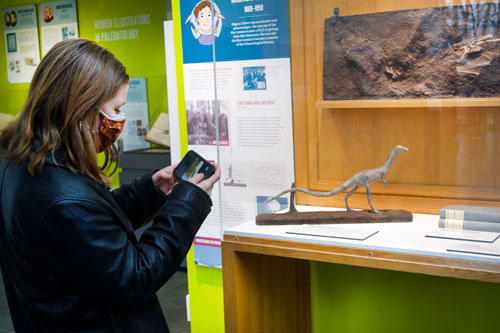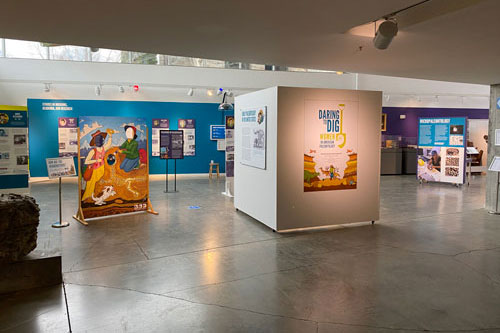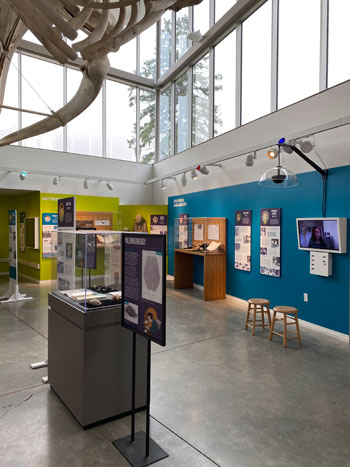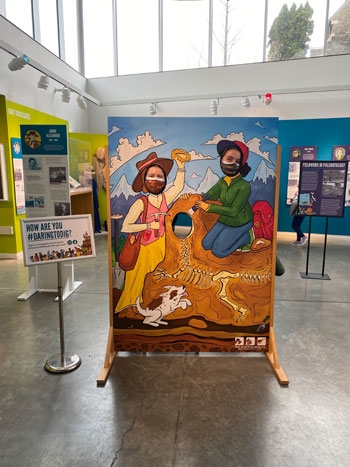Grant Spotlight | June 21, 2021
Share ThisJune 22, 2021

“I hope visitors are inspired by the stories of these women and see the progress that has been made, while realizing we still have more to achieve to have equity in science.”—Helaina Blume, Director of Exhibitions, Paleontological Research Institution
It all started with the children’s book Daring to Dig: Adventures of Women in American Paleontology, by former Paleontological Research Institution (PRI) Director of Exhibitions Beth Stricker. The book takes young readers on a journey of women’s experiences not just in science, but also in the pursuit of career advancement. On March 28, 2021, it grew into more than a hard copy experience, with the opening of an in-person and virtual exhibit at PRI in Ithaca, New York, thanks to funding from the Institute of Museum and Library Services.
“We were able to design the exhibit to allow visitors to explore the lives of women paleontologists, learn the prejudices they faced and still face today, and see some of their greatest accomplishments,” said Helaina Blume, current Director of Exhibitions at PRI. “After experiencing this exhibit, we hope visitors have a better understanding of the history of women in science, a greater respect for the pioneering women who were first in their fields, and a motivation to learn more—and perhaps do something—about gender inequality in science.”

By bringing the book to life through research, writing, technology development, and fabrication, PRI is helping a broader audience gain an appreciation for the accomplishments of women in paleontology, as well as the challenges faced by historical and contemporary women through the stories of these influential paleontologists.
Unearthing Inequities
In the 1700s and 1800s, women were not permitted to attend universities or join scientific societies. Since art was considered an acceptable pastime, Cecilia Beaux, Sarah Hall, Orra Hitchcock, and many other women began illustrating specimens for male family members and friends. They were rarely paid or credited for their published work. By the late 1800s, women, including Mignon Talbot, were attending college, joining societies, and becoming established professors. A few financially independent women, like Annie Alexander, could support their own expeditions.
While women no longer face many of the barriers that they once did, the work of achieving equity in paleontology is still ongoing.
“In the 21st century, paleontology is becoming a more welcoming science for everyone, regardless of sex, gender identity, sexual orientation, race, ethnicity, class, or ability,” explained Blume.

After experiencing the exhibit, Blume hopes visitors will understand that science is connected to the broader cultural context in which it is practiced, as well as the complexity of the roles that gender and society have played, specifically in paleontology.
Another goal of the exhibit is to allow young women and girls to feel welcome in the field of paleontology and to be inspired by the past and present women role models and mentors who are featured in the exhibit.
“I loved learning about and being inspired by these women,” said Blume. “They have faced prejudices and still face them today, but they have continued to persevere and helped shape the field of paleontology.”
Digging into the Details
Curating stories that would leave a “footprint” was an important factor in creating the exhibit. In addition to fielding visitor surveys, PRI turned to social media to request submissions from women paleontologists in the field today so they could share their stories in the exhibit.
“We included illustrations, photographs, interviews, videos, specimens, and objects in the exhibit,” said Blume. “We even enlisted Alana McGillis—the illustrator of the children’s book—to work with us again on the exhibit and to create illustrations, videos, and activities geared toward our younger audience that highlights the women in the exhibit.”
However, the project team did run into a problem: They couldn’t fit everything they gathered into the allotted physical space! Thus, the virtual version was born, allowing them to include additional content and information and help an even wider audience experience and learn from the exhibit.

The enthusiasm for and engagement with women’s experiences in paleontology has been high since the exhibit launched in March. It will be on display through December 2021, and PRI has already hosted a few panels of women paleontologists with plans for more workshops and programs in the fall, in addition to virtual field trips.
Blume is excited for the positive and lasting impact that this exhibit will make in the future.
“I’m thrilled that we’re able to look to the women in this exhibit to understand how paleontology has changed and to consider how to develop new paths for progress today and tomorrow,” said Blume.
About the Project
Grant Project Name: Daring to Dig: Women in American Paleontology
Grant Log Number: MA-10-16-0318-16
Year Awarded: 2016
Recipient: Museum of the Earth at the Paleontological Research Institution
Project Contact:
Helaina Blume
Director of Exhibitions
Paleontological Research Institution
hjb95@cornell.edu
Website: https://www.museumoftheearth.org/exhibit/daring-to-dig
